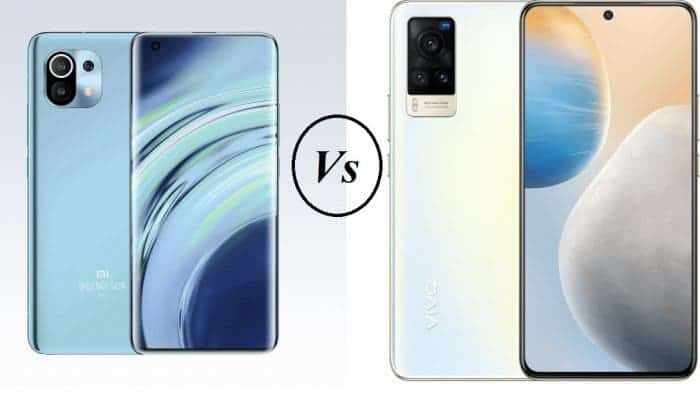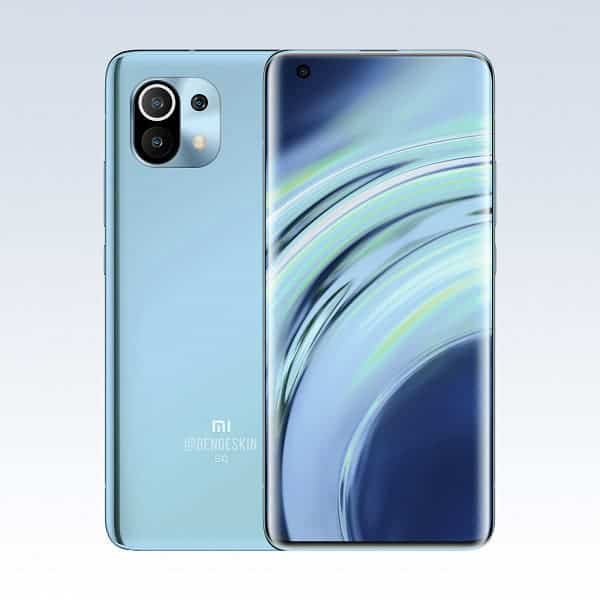With the arrival of the Snapdragon 888, there is a “cold” impression that only this chip can give you the perfect performance. However, it is interesting to note that there are other new chips that are as tough. The recently released Samsung Exynos 1080 is one of them. This chip uses the same Samsung 5nm manufacturing process as the Snapdragon 888. While the Xiaomi Mi 11 prides itself as the pioneer device of the Snapdragon 888, Vivo X60 is the pioneer device of the Exynos 1080. Both the Xiaomi Mi 11 and Vivo X60 are flagship killers and their prices are interesting.
The Xiaomi Mi 11 can easily pitch against the Vivo X60 Pro but there will be a Mi 11 Pro. We believe that it is best for the Pro models to do battle with each other. This comparison looks at the specifications of two smartphones from Chinese brands. Of course, they were the last devices of 2020. Interestingly, you will not really have to break the bank for any of these devices.
Read Also: Xiaomi Mi 11 FAQ: All Questions Answered
Xiaomi Mi 11 vs Vivo X60
Design
Looking at the front, there is no much design difference between the Mi 11 and the Vivo X60. However, if you love a rounded device, the Mi 11 will be your choice. The Mi 11 uses a more rounded overall design with a curved screen on all four edges and a punch-hole camera to the left of the display. The Vivo X60 on the other hand uses a straight display and a center punch-hole design. Although the overall design of the Vivo X60 is round, it is not as round as the Xiaomi Mi 11. Both smartphones have a high screen-to-body ratio which is a plus for both of them. However, the Vivo X60 prides itself as the thinnest 5G phone ever with a thickness of only 7.4mm. The Xiaomi Mi 11 is 8.1mm thick.
However, the main design difference is on the rear of these smartphones. The Xiaomi Mi 11 prides itself on its original rear camera module design. The camera module has rounded edges and the triple cameras are within this module. The Vivo X60 uses the more regular vertical camera module with three sensors. The main sensor is the large sensor on top while the other two smaller sensors are beneath the main sensor.
Display
On the display capabilities itself, the Xiaomi Mi 11 has an edge. This display is one of the most expensive in the industry. DisplayMate rates the Mi 11 display A+. In addition to the 120Hz refresh rate, this display also supports Quad HD+ resolution, high brightness up to 1500 nits, and HDR10+. This display also uses the Corning Gorilla Glass Victus, supports 1B colors and the pixel density reaches 515. For the Vivo X60, its AMOLED also supports a 120Hz refresh rate and HDR10. However, the pixel density (398) and display resolution are lower than that of the Mi 11. Both displays come with an on-screen fingerprint sensor.
Gizchina News of the week
Xiaomi Mi 11 Vs Vivo X60 – specs sheet
General |
Xiaomi Mi 11 Vivo X60 | |||
| SIM Type | Dual SIM(GSM+GSM) | Same Dual SIM | ||
| Dual SIM | Yes | Yes | ||
| Sim Size | Nano+Nano SIM | Nano+Nano SIM | ||
| Device Type | Smartphone | Smartphone | ||
| Release Date | December 28, 2020 | December 29, 2020 | ||
| Design | ||||
| Dimensions | 164.3 x 74.6 x 8.06 mm | 159.63 x 75.01 x 7.36 mm | ||
| Weight | 194 g | 175.6 g | ||
| Display | ||||
| Type | Color AMOLED screen (1B ) | Color AMOLED screen (16M) | ||
| Touch | Yes, with Multitouch | Yes, with Multitouch | ||
| Size | 6.81 inches, 1440 x 3200 pixels, 120 Hz | 6.56 inches, 1080 x 2376 pixels, 120 Hz | ||
| Aspect Ratio | 20:9 | 19.8:9 | ||
| PPI | ~515 PPI | ~388 PPI | ||
| Screen to Body Ratio | ~ 91.4% | ~ 92.76% | ||
| Features | HDR10+, Sunshine screen 3.0, Eye Protection Reading Mode | HDR10 and HDR10+ | ||
| Notch | Yes, Punch Hole | Yes, Punch Hole | ||
Memory |
||||
| RAM | 8 GB / 12GB | 8 GB | ||
| Storage | 128 GB / 256GB | 128 GB / 256GB | ||
| Storage Type | UFS 3.1 | UFS 3.1 | ||
| Card Slot | No | No | ||
| Connectivity | ||||
| GPRS | Yes | Yes | ||
| EDGE | Yes | Yes | ||
| 3G | Yes | Yes | ||
| 4G | Yes | Yes | ||
| 5G | Yes | Yes | ||
| VoLTE | Yes, Dual Stand-By | Yes, Dual Stand-By | ||
| Wifi | Yes, with wifi-hotspot | Yes, with wifi-hotspot | ||
| Bluetooth | Yes, v5.2, A2DP, LE, aptX HD, aptX Adaptive | Yes, v5.1, A2DP, LE, LDAC, aptX HD | ||
| USB | Yes, USB-C v2.0 | Yes, USB-C | ||
| USB Features | USB on-the-go, USB Charging | USB-Charging | ||
| Wireless Charging | Yes, 50W | |||
| IR Blaster | Yes | |||
Extra |
||||
| GPS | yes with A-GPS, GLONASS, GALILEO, BDS, QZSS, NavIC | yes with A-GPS Beidou, Galileo, QZSS, GLONASS | ||
| Fingerprint Sensor | Yes, In-Display | Yes, In-Display | ||
| Face Unlock | Yes | Yes | ||
| Sensors | Ultrasonic Distance Sensor, Ambient Light Sensor, Acceleration Sensor, Gyroscope, Electronic Compass, X-axis linear Motor, Infrared Remote Control, Grip Sensor | Light sensor, Proximity sensor, Accelerometer, Compass | ||
| 3.5mm Headphone Jack | No | No | ||
| Extra | NFC | NFC | ||
| IP Rating | IP68 | |||
Camera |
||||
| Rear Camera | 108 MP f/1.9 (Main) 13 MP f/2.4 (Ultra Wide) 5 MP f/2.4 (Macro) with autofocus |
48 MP f/1.79 (Wide Angle) 13 MP f/2.2 (Ultra Wide) 13 MP f/2.46 (Portrait) with autofocus |
||
| Features | Panorama Mode, Professional Mode, Dynamic Photo, Countdown Photography, HDR, AI Beauty, AI Smart Slimming | Night scene, Portrait, Panorama, Dynamic Photo, Slow Motion, Short Video, High Pixel, Professional Mode, Time-Lapse Photography, AR cute Shooting, Document Correction, Sports Capture, Starry Sky | ||
| Video Recording | 8K, 4K, 1080p | 4K, 1080p | ||
| Flash | Yes, LED | Yes, LED | ||
| Front Camera | 20 MP | Punch Hole 32 MP f/2.45 | ||
| Front Video Recording | 1080p, 720p | 1080p | ||
Technical |
||||
| OS | Android v11 | Android v11 | ||
| Chipset | Qualcomm Snapdragon 888 | Samsung Exynos 1080 | ||
| CPU | 2.84 GHz, Octa Core Processor | 2.8 GHz, Octa Core Processor | ||
| Core Details | One core of 64-bit Kryo 680 based on ARM Cortex-X1 at up to 2.84GHz, along with three Kryo 680 cores based on Cortex-A78 at up to 2.42GHz and four cores of Cortex-A55-based Kryo 680 at up to 1.8GHz. | 4 x Cortex-A55 cores clocked at 2.0GHz, 3 x Cortex-A78 cores clocked at 2.6GHz, and 1 x Cortex-A78 core clocked at 2.8GHz. | ||
| GPU | Adreno 660 | Mali G78 | ||
| IP Rating | IP68 | |||
| Java | No | No | ||
| Browser | Yes, supports HTML5 | Yes, supports HTML5 | ||
| Multimedia | ||||
| Yes | Yes | |||
| Music | MP3, FLAC, APE, AAC, OGG, WAV, WMA, AMR, AWB | AAC, AMR, MIDI, OGG, FLAC, WMA, WAV, APE, MP3 | ||
| Video | MP4, MKV, AVI, WMV, WEBM, 3GP, ASF playback | Yes | ||
| FM Radio | No | Yes | ||
| Document Reader | Yes | Yes | ||
Battery |
||||
| Type | Non-Removable Battery | Non-Removable Battery | ||
| Size | 4600 mAh, Li-Po Battery | 4300 mAh, Li-Po Battery | ||
| Fast Charging | 55W Fast Charging + 50W wireless charging | 33W | ||
| Reverse Charging | Yes | |||
Hardware/Software
While the Xiaomi Mi 11 uses the Snapdragon 888 SoC, the Vivo X60 comes with the Exynos 1080 SoC. Both chips use Samsung’s 5nm manufacturing process. However, in terms of performance databases and tests, the SD888 has a slight edge. In addition, the Mi 11 has up to 12 GB of RAM and 256 GB of UFS 3.1 native storage. The Vivo X60 also offers the same thing only that it has up to 8GB of RAM. In terms of software, the Mi 11 uses MIUI 12.5 on top of Android 11. The Vivo X60 comes with OriginOS on top of Android 11.
Camera
One of the downsides of the Xiaomi Mi 11 is that it only supports an ultra-wide angle and a macro camera. This means that there is no telephoto or a periscope sensor which means that it does not support optical zoom. However, the Mi 11 still have one of the best image output with its 108MP main sensor. With the Vivo X60, you can get optical zoom with its Carl Zeiss lens which offers the best. However, in the video aspect, while the Vivo X60 offers 4K@30fps, the Mi 11 offers 8K@24/30fps.
Battery
In the battery aspect, the Xiaomi Mi 11 takes a straight victory. Its battery is not only bigger, it supports faster charging. The Mi 11 supports a 4,600 mAh battery that supports 55W fast charging. For the Vivo X60, it comes with a 4,300 mAh battery that supports 33W fast charging. In addition, the Mi 11 also supports 50W wireless charging and 10W reverse charging – features that Vivo X60 lacks.
Price
The price of the Xiaomi Mi 11 starts from $611 while the Vivo X60 Pro starts from about $540. We can understand why the Xiaomi Mi 11 is more expensive. The display, hardware, and battery of this device are great. However, the camera of the Vivo X60 has some interesting features
Xiaomi Mi 11 Vs Vivo X60: PRO and CONS
Xiaomi Mi 11
PROS
- Good hardware
- Wireless charging
- Reverse wireless charging
- Original design
- Top display
CONS
- Inferior camera
Vivo X60
PROS
- Great camera
- Thinner & Lighter
- Good 5 nm chipset
CONS
- Smaller battery








Xiaomi Mi 11 IP68? I don't think so…. 😉